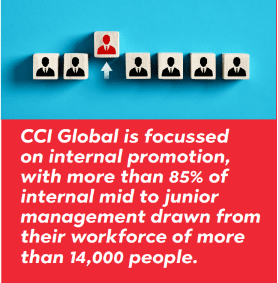Organisations should prioritise cultural fit, skills gaps, and key competencies when searching for new hires.
By Simon Kent
The ability to quickly and effectively assess candidates has revolutionised recruitment. For large volume and/or temporary workforces, technology provides the ability to check candidates, assess their aptitude, and line them up for work without much—if any human—intervention. While assessments may be useful for more demanding and mission critical roles, it is by no means straightforward. The diversity agenda and the need to design bias out of the equation is taken as read, but ultimately are employers looking for new recruits who present the same profile as currently successful employees, should they look for complimentary characteristics, or should they, in fact, be looking for entirely different viewpoints, ideas, and approaches? Which of these options would enrich and advance the way organisations do business?
Summeya Beukes is senior talent acquisition specialist for African-based BPO CCI Global. She notes that the work they carry out for their partners requires a high level of skill—from emotional connection and cultural fit to complex technical skills. As such, the assessment process is critical to reveal if candidates are up to this demanding environment.
Their assessment process is comprehensive and diverse. A technical assessment is usually the first stop to ensure the candidate knows the job, but this is followed by a time-sensitive case study-based task. “Here we are asking the potential senior hire to provide their technical knowledge and decision-making skills on a particular project,” explains Beukes. “As the case study is highly time-sensitive we can tell from a candidate’s work how accurate they are, how fast they are, and understand their deep level of thinking. Most importantly we can tell their commitment to work.”
Beukes goes on to say that organisational fit is key to their business because their people are often working on the frontline for clients. The company will then hold joint intake and recruitment meetings with their clients, working from a brief for the type of hires that business wants. This covers personality, key competencies, and experience. “Once the new candidate is in place, we will work with the outsourcing client to follow up and refine these intake meetings and recruitment briefs to make sure the next hire is even further optimised for organisational fit,” she says.
To further ensure cultural fit, potential candidates are asked to spend a minimum of five hours in CCI’s offices or at contact centre sites. For more senior hires, this can extend to as much as a few days or a week. “By doing these ‘office days’ we can feel how they feel in terms of their alignment to CCI and how they fit in,” she says. “We are very vibrant and fast-paced, and we need hires to be this type of person. Morbid personalities will not thrive.”
“We would underpin this approach as ‘immersion into the environment,’” she adds. “People not just saying they will be a good fit, but by people showcasing in front of our eyes that they are, alongside prior technical assessments.”
Beukes states that CCI Global is very focussed on internal promotion, with more than 85% of internal mid to junior management drawn from their workforce of more than 14,000 people. “Yes people who bring in new ideas are great, and we need people like that, but we focus on what we can see with our own eyes,” asserts Beukes. “Especially as we are an African first operating in countries such as South Africa, Kenya, Rwanda, and Ghana and take pride in being African experts, we need people who are experts in our line of work.”
But while near precise cultural fit is critical for CCI, in other scenarios this could be one of the least important aspects. WithYouWithMe was created to help address the digital skills gap and as such targets less orthodox candidates, providing them with the technical skills they need in the digital workplace. Rather than considering culture fit, the assessment process centres on aptitude and reasoning, determining whether the potential candidate has the right qualities here for specific digital roles.
Having established this, WithYouWithMe gives that person the training they need to take on the most appropriate role. James McLaughlin, U.K. vice president of the organisation, asserts this approach is powerful in getting people into work but it also offers a way for employers to become flexible and agile in their operation.
“If you need to pivot what you’re doing you can assess what skills these people have that can work elsewhere in an organisation, rather than just sacking them,” he says. “We’re also helping people with career opportunities because if you have the right skills, progression doesn’t always need to be upwards. You can be right for a new role which delivers value in a different way.”
McLaughlin acknowledges that this approach to assessment requires organisations to take a significant shift away from previous job and experience-based models, but from a diversity and flexibility point of view it can underpin a great new way to manage people.
Naturally, what a business concentrates on when assessing will depend on their needs. As Sam Price, talent solutions director at Morson suggests, some industries may need a level of diversity to move forward: “If you’re on a transformation journey in a field like nuclear, is only hiring from nuclear backgrounds the right way to go?” she asks.
Morson uses assessments to build teams which demonstrate diversity of thought. “If you want to do something dramatic and change worthy, that’s what we’re looking at,” she says, “but what we’re also looking at, when we do a values-based assessment, is if someone is divergent from the values of the business, will that make them successful in the role?”
Price has hit upon a tricky balancing act here, and it is one, perhaps which can only be determined by the circumstance of that specific hire. Diversity of thought, notes Price, does not mean an individual cannot be aligned to the same values as someone else. “We can be aligned on values but still very diverse in our thought processes and our experiences. So that’s where we see assessments coming into their own,” she says.
Using assessments to build teams therefore goes beyond simply checking the right boxes are ticked and understanding the impact a certain aspect of a candidate could have in the workplace. Determining the elements that are important to be assessed and whether these should be in alignment or diverse is dependent on the organisation and position under consideration. The important thing in each instance is to ensure the assessments are accurate and fair in what they set out to measure.
















